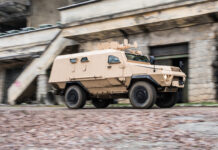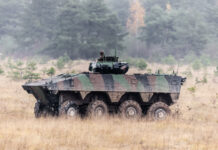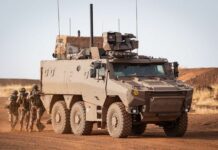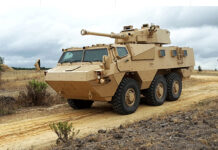The armoured vehicle spectrum is quite broad, and includes many 4×4 systems. The 4×4 configuration has the advantage of being generally more mobile than larger and heavier vehicles, whether tracked or 6×6/8×8 wheeled systems.
At the same time, these vehicles are designed from the beginning with a significant armour suite and offer a higher level of protection than up-armoured vehicles such as the HUMVEE. They are available in numerous variants, including general purpose tactical transports (personnel and cargo), scout vehicles, light armoured fighting vehicles with turret mounted guns, and specialized units such as field ambulance or command vehicle.
Textron COMMANDO
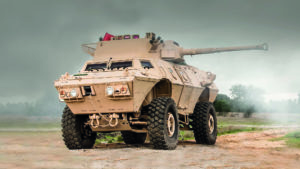
One of the most ubiquitous and versatile examples is the COMMANDO family of vehicles which has been in production since the Vietnam War. Textron Marine and Land Systems currently produces three different lines of COMMANDO vehicles built on a common chassis. They are designated respectively as Advanced (optimised for internal security, armoured personnel carrier or APC, and reconnaissance), Select (APC, MedEvac, and direct fire support vehicle) and Elite (reconnaissance/surveillance/target acquisition, command and control, liaison vehicle). Depending on variant and mission, weapons options include a remote-controlled weapon station (RWS) or turret dual-armed with a machine gun and 40mm grenade machine weapon; a 30mm to 90mm guns; anti-tank guided missiles (ATGMs); or a 120mm mortar. Depending on variant, the three-person crew can be augmented by up to eight soldiers.
Performance parameters are similar throughout the family. Cross country and obstacle clearing characteristics include a 1.5-metre fording capability, a gradient and side-slope handling of 60% and 30%, respectively, and head-on clearance of circa 60% high obstacles. The v-shaped monocoque hull provides ballistic and blast protection up to STANAG level 4. Road speeds run in the 100-110 kph range, with an on-road mission range of nearly 650 kilometres. Curb weight varies with configuration, but averages around 15,000 kg. The current COMMANDO vehicles are configured with a so-called digital backbone which enables monitoring of on-board systems; it also allows them to accept a wide range of current and future vectronic and sensor systems, and plug into battlefield networks. The vehicles can be airlifted singly by CH-53; up to six can be loaded onto a C-130, and roll off combat ready.
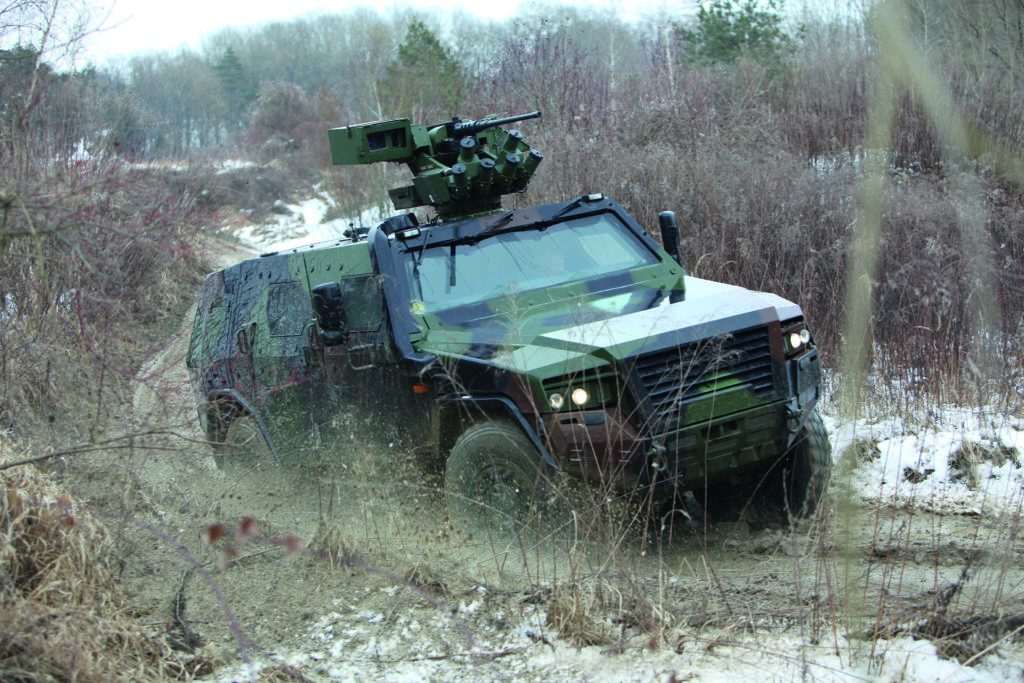
Oshkosh JLTV
Oshkosh Defense’s Joint Light Tactical Vehicle or JLTV weighs in at 6,400 kg, less than half the COMMANDO’s mass. This translates into greater manoeuvrability and a somewhat higher top speed of 120 kph. The smaller vehicle does come with a lower level of protection. The A-structure, or base vehicle, includes a blast-deflecting vee-shaped hull, bulletproof windows, an armoured crew cabin, blast-protected seats and an automated fire extinguishing system. The modular B-kit add-on armour suite provides enhanced protection against small arms, fragmentation, and underbody threats, effectively increasing crew protection to MRAP levels. A forward looking camera enhances driving safety and situational awareness.
Modularity is one of the JLTV’s major assets. It comes in two basic variants, the two-seat Combat Support Vehicle (CSV) and the four-seat Combat Tactical Vehicle (CTV). The CSV has a flatbed which can haul cargo or be outfitted with a shell; prototypes of a CSV mounting surface to air missiles, a 105mm howitzer, or an ambulance module have been presented. The CTV comes in three sub-variants which are optimised, respectively, as troop carriers or weapons platforms mounting automatic weapons up to 30mm, ATGMs, or air defence weapons. Oshkosh expects to regularly upgrade the JLTV over the coming decades, so that this class of vehicle – or an immediate derivative – might serve through the end of the century.
AM General and Arquus

US Firm AM General has partnered with France’s Arquus on modifying and manufacturing the French designed 12,500 kg BASTION APC. The US-built variant is marketed through the US government’s foreign military sales channel. The armoured vehicle is based on the chassis of the unarmoured Arquus VLRA truck. It is optimised for peacekeeping, reconnaissance and combat missions. Exportability is enhanced by the optional left- or right-hand drive. In addition to the APC role, it can be configured as an ambulance, command vehicle, maintenance vehicle or cargo transport. Capacity includes 2 plus eight in the APC role. The BASTION is suitable for all operating environments. The motor is certified for operations at -32 degrees Celsius. The central tire inflation system and run-flat tires maintain mobility over broken terrain. The vehicle can scale a 60% incline and cross an 80 centimetre trench; fording depth is one metre. On road speed maxes out at 110 kph, with a 1,000 km unrefuelled range.
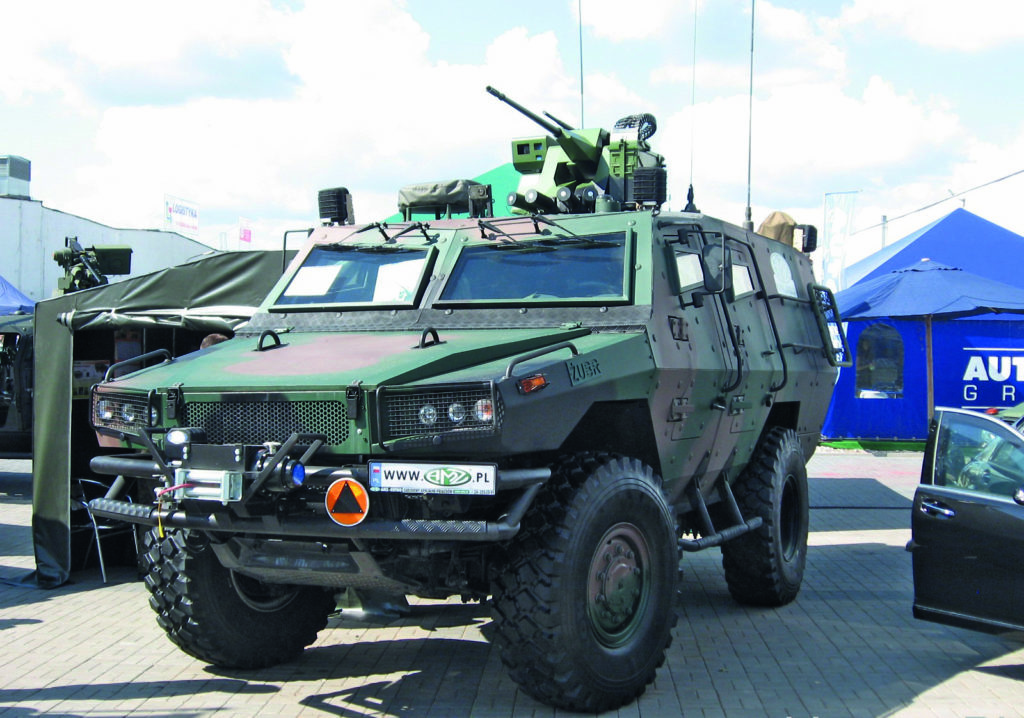
Standard armament consists of a single machine gun (7.62mm or 12.7mm) or 40mm grenade weapon on a ring mount or RWS. Passengers can deploy personal weapons through six firing ports in the hull. Survival equipment includes blast resistant seats, smoke grenade launchers, a sniper acoustic detection system, laser detection system, an IED jammer, and day/night wide area surveillance cameras. Ballistic and blast protection are rated up to Stanag level 3 and level 2a/2b, respectively.
Arquus
Arquus also offers the French-built 14.5-ton FORTRESS which is based on the BASTION. It can be configured as a troop transporter or logistics vehicle; the APC variant can itself be reconfigured as a command vehicle, ambulance or repair/maintenance vehicle. The armoured monocoque hull provides protection against ballistic impact as well as mine and IED blast. The vehicle requires a crew of two, and can seat eight combat ready dismounts (APC configuration). The FORTRESS can accommodate a wide range of ring- or RWS-mounted weapons up to 30mm guns. Internal configuration includes the full-range of the Arquus BattleNet vectronics system for networking onboard systems and weapons as well as plugging into tactical data networks. The FORTRESS offers excellent mobility over all terrain types, and is in service not only with French forces but also with several African and Middle Eastern nations. Speed and range parameters are 120 kph and 1,200 kilometres, respectively. The FORTRESS can be airlifted by C-130/M400 class aircraft.
Nexter ARAVIS
Another multi-tasking armoured vehicle is the Nexter ARAVIS. Some 300 have been produced, with the majority delivered to Saudi Arabia between 2013 and 2016. French reconnaissance forces and combat engineers have deployed their ARAVIS, designated Véhicule Blindé Hautement Protégé or highly protected armoured vehicle, to Afghanistan, Syria, and Africa. Alternate uses are as convoy escort, fire support, MedEvac or command and control vehicles. For observation missions the ARAVIS can be outfitted with the Thales Margo 5000 surveillance which includes mast-mounted electro-optical sensors and a laser rangefinder/targeting system. In APC mode the vehicle carries a crew of two plus six dismounts.
The 12,500 tonne ARAVIS utilises a specially patented modular armour which Nexter has named SafePro. It offers protection up to Stanag level 4 against mines and IEDs as well as against 14.5mm armour-piercing rounds and 155mm artillery shell fragmentation. This is the highest level of protection of any contemporary 12,000 kg class vehicle. Weaponry typically consists of a top-mounted RWS with either a 12.7mm machine gun, 40mm grenade weapon or 20mm automatic cannon. The vehicle offers high mobility in urban and cross-country terrain. Road speeds of 100 kph and a range of 750 kilometres are achieved.

Iveco MPV and MMPV
The 18-tonne 4×4 Medium Protected Vehicle (MPV) has its roots in a joint Italo-German agreement between Iveco and Krauss-Maffei-Wegmann (KMW) in 2008. The core design is created by placing an armoured shell on top of the all-terrain TRAKKER MOTS truck chassis. The shell incorporates both the cab and the mission compartment. The latter has a standard size of 13 cubic metres, expandable to 16 cubic metres for the ambulance and intensive treatment vehicle. To maximise occupant safety, the shell is designed to separate as a whole from the chassis in case of a major explosion, allowing the energy from the detonation to dissipate rather than focus on the occupied portion of the vehicle.
The Iveco MPV is currently being produced in ambulance, troop carrier and route clearance variants. The modular aspect of the MPV is evident when viewing the standard five-vehicle route clearance convoy. Each of the five vehicles is optimised for a particular contribution to the mission of detecting and neutralising IEDs and other threats. Specific equipment for these vehicles include sensor masts for reconnaissance and manipulator arms for mine and IED neutralisation. The MPV’s terrain performance includes a fording capability of up to 120 centimetres (with preparation). Gradient and side-slope capacity are given at 60 and 30%, respectively. Road speed exceeds 90 kph. Run flat tires and a central tire inflation system enhance terrain mobility.
Iveco has also developed a Medium Multirole Protected Vehicle (MMPV) based on its proven Light Multirole Vehicle (LMV). The 8,000 kg vehicle accommodates five, and mounts either a manually served or RWS-based weapon. The vehicle has a welded ballistic steel monocoque augmented by roll bars. IED protection is further enhanced by the addition of a third hinge added to each door and the use of new materials. Crew comfort is enhanced by a new ergonomic design. The 8-speed transmission, suspension and electronic stability control system are all new, enhancing off-road performance and safety. The Netherlands armed forces signed a procurement order for an initial batch of 918 MMPV, which will carry the in-service designation 12kN. Deliveries are slated for 2022-2026.
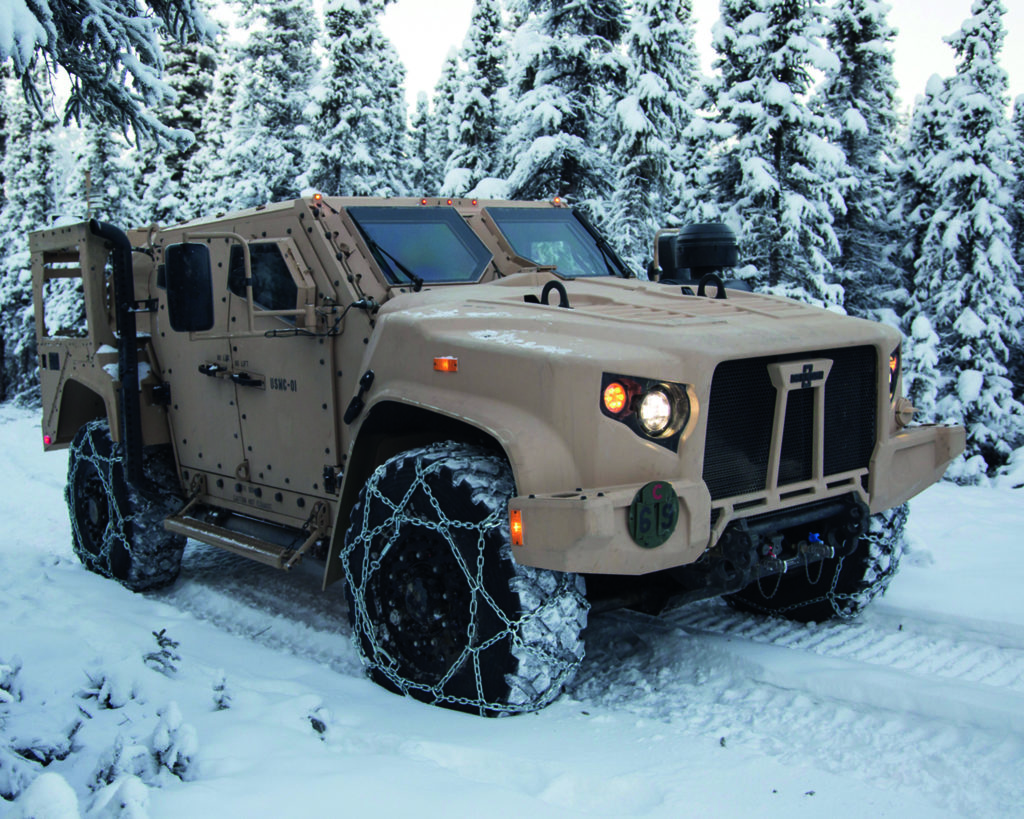
Armoured Multi-Purpose Vehicle
Rheinmetall and Krauss-Maffei-Wegmann (KMW) describe their jointly developed Armoured Multi-Purpose Vehicle (AMPV) as “the next generation of protected vehicles.” It is generally considered comparable to the US armed forces’ new Joint Light Tactical Vehicle, but is heavier with a higher level of protection. The steel and composite armoured passenger cell provides a high level of blast and fragmentation protection, and features NBC filtration. Bullet-resistant windows provide a wide field of vision. Add-on armour is available for high threat environments. The ergonomically configured interior minimises passenger fatigue.
Handling characteristics are compared to those of an SUV, with a turning circle of 15 metres, making the AMPV suitable for field and urban deployment. The independent suspension and central tire pressure control system facilitate operations in difficult terrain. The vehicle can climb a gradient of 70%. The maximum road speed is 110 kph, with a 700 kilometre operational range. AMVP can be configured with any type of RWS, and can typically be armed with either a machine gun (up to calibre 12.7mm) or a 40mm grenade machine weapon.
Two variants have been designed. KMW describes the smaller variant, designated Type 1, as ideal for service as an agile liaison or patrol vehicle. The Type 1 seats four, has a gross weight of 7,500 kg, and can be internally transported by CH-53. The type 1 is still in the conceptual phase. The Type 2 is larger, with a base weight of 10,000 kg and a payload capacity of 2-2.5 tonnes, depending on armour configuration. Passenger capacity is five including the driver. The Type 2 can be airlifted by C-130-class aircraft.
AMZ ZUBR
Polish manufacturer AMZ-Kutno produces three armoured 4×4 vehicles. The heaviest is the 14,000 kg ZUBR, which is based on the Iveco EuroCargo 4×4 truck license-built in Poland. The ZUBR is available in four variants: APC, command and control, air surveillance (with an N-26 radar), command and control, and short-range air defence (armed with GROM missiles). The APC can carry two crew plus ten combat-equipped infantrymen and is equipped with a remote weapon station mounting a machine gun or 30mm automatic grenade weapon. The hull is vee-shaped to deflect mine and IED blast. The sides of the vehicle are also angled outward to deflect ballistic threats. The crew/passenger compartment is armoured to STANAG level 4 against armour-piercing rounds and artillery fragmentation, and to level 3a/3b against anti-personnel mines. Additional modular armour can improve this protection level. The high wheel base, independent suspension and run flat tires offer good off-road handling, including a fording capability of 70 centimetres and approach/departure angles of 35/33 degrees. The vehicle can tow a 1,500 kg trailer. Performance includes a top road speed of 100 kph and a range of 1,000 kilometres.

Tatra / HCP HUSAR
Polish manufacturer H. Cegielski-Poznan (HCP) presented the new HUSAR 4×4 armoured vehicle at Warsaw’s MSPO 2017 expo. Designed in cooperation with the Czech firm Tatra Defense Vehicle, the high mobility HUSAR features a modular design that simplifies maintenance and upgrading; this also simplifies optimisation for various mission types including command and control, reconnaissance, and anti-tank configurations. Operations are possible in a wide range of climatic zones including high and low temperature environments. Standard armament solutions involve an RWS with a choice of machine guns or automatic grenade weapon. Optional equipment include NBC protection and an active protection system.
The 13,500 kg vehicle has a payload capacity of 1,600 kg. Seating is available for the driver, gunner and four dismounts. The bolted ed hull provides level 3 protection against ballistic threats and level 2a/2b blast protection. The protected drivetrain and independent suspension allow the vehicle to adapt immediately to changing terrain. Tire inflation and deflation are controlled from the cockpit. The vehicle can master a 1.2-metre fording depth and 40 degree side slopes. Top road speed is 110 kph. Maximum range varies from 300 km cross country to 500 km
on road.
BOV 16 MILOSZ
The BOV 16 MILOSZ armoured vehicle designed by Yugoimport entered production in 2016. The multi-purpose combat vehicle is offered in several variants including special operations reconnaissance, artillery reconnaissance, command vehicle, anti-tank vehicle and ambulance. The turning radius is nine meters, making the vehicle highly suitable for urban and field operations.
The 14,000 tonne vehicle can mount machine guns and grenade weapons, anti-tank guided missiles, short-range air defence missiles, and telescopic masts with electro-optical /infrared sensors and radar. Sensors also include hull-mounted day and night-vision cameras to aid the driver. Run flat tires preserve the vehicle’s mobility for 50 km after tires suffer serious damage.
The sheet steel armour offers Stanag level 3 ballistic protection in front and level 2 on the sides, and level 2a/2b blast protection. Additional modular armour is optional. Damaged armour segments can be replaced in the field. Five portholes in the hull permit mounted crew to fire their personal weapons under armour. The vehicle seats eight including the driver and gunner. Four of these personnel are seated in the rear section and disembark quickly via a hydraulic ramp, while the remaining crew disembark through standard vehicle doors.
Zetor GERLACH

The 12 tonne GERLACH armoured vehicle developed by the Czech Republic’s Zetor Engineering is available in five configurations including personnel transport, open-bed cargo transport (1,500 kg capacity), and ambulance. The combat vehicle variant was presented in 2019. In addition to a machine gun or grenade weapon equipped RWS, the new variant can deploy a mortar or anti-tank guides missiles.
Regardless of configuration, the GERLACH presents as a highly mobile terrain capable vehicle. The turning radius of 7.5 metres is among the narrowest for vehicles of this class. During testing the fully loaded prototype was able to master a one-meter trench, a 70% gradient and a 40% side slope. The vehicle achieves a top speed of 125 kph on road, and has an 800 km operational range. During testing, the vehicle demonstrated the capability to tow a 28 tonne truck for one hour without overheating the engine.
Depending on configuration the Gerlach can accommodate up to six persons including the two-person vehicle crew. The overpressurized crew cabin features multi-layer Rheinmetall armour which provides STANAG Level 3 protection against ballistic threats and level 2 protection (upgradable to level 3) against blast threats. The double-floor vee shaped hull is specifically tailored to minimise the threat from mines; during testing the prototype survived an 8 kilo TNT charge detonating directly beneath the vehicle. In addition, the cabin is designed for noise and vibration dampening, minimising crew fatigue. Zetor stresses that all major components are manufactured and procured in the EU, in hopes of appealing to European users.
Otokar COBRA
Otokar’s battle-tested COBRA armoured vehicles have a modular design which permits customisation in a large variety of configurations including (but not limited to) APC, combat support vehicle, reconnaissance and surveillance, or NBC reconnaissance. The COBRA can optionally be equipped with two hydraulic thrusters and a joystick control, making it one of the few 4×4 armoured vehicles with an amphibious capability (at a speed of 8 kph).
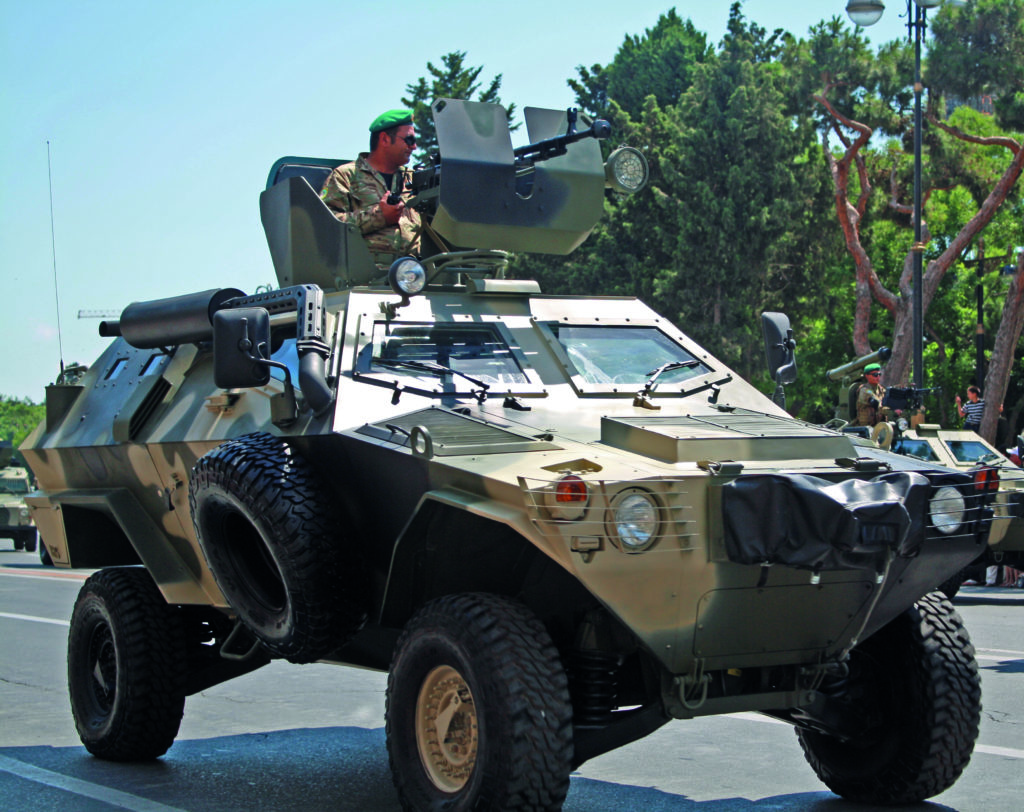
The 6,700 kg vehicle seats up to 9 occupants. The cab and passenger section as well as the engine compartment are armoured. The angular design of the steel-armoured monocoque enhances protection by naturally deflecting projectiles (including armour-piercing munitions) and blast energy from anti-personnel and anti-tank mines. A dual-floor structure further mitigates shock waves from mines. A variety of weapon stations or turrets can be mounted, bearing automatic weapons up to 20mm as well as ATGMs and air-defence missiles. These stations can also carry night-vision periscopes, thermal imaging sensors and fire control systems.
The more conventional looking COBRA II offers enhanced ballistic and blast protection as well as increased payload and internal volume, while matching the original variant’s mobility, modularity and amphibious capability. The 13,500 kg vehicle seats 10 including the driver and commander. The APC variant includes firing ports. Maximum road speed is 110 kph, with a range of 700 km, somewhat better than the original COBRA’s performance.
FNSS PARS
The FNSS PARS is available in four configurations: command and control (with a RWS-mounted 12.7mm machine gun), armoured tactical vehicle (RWS with a machine gun or 40mm grenade weapon), reconnaissance and surveillance (telescopic sensor mast), or anti-armour (remotely operated ATGW mount). The driver and commander displays are linked to externally mounted day and night vision cameras. The vehicle and the four-person crew are protected by modular armour, transparent ballistic armour cockpit windows, explosion and leak resistant fuel tanks, mine resistant seats, and CBRN protection.
The PARS has a low centre of gravity and a fully independent double-wishbone suspension which enhances operations on rough terrain. It can master 70% vertical slopes and 40% side slopes. The automatic transmission includes an axle-lock for improved traction on slippery surfaces and soft soil. A front-mounted hydraulic winch permits self-recovery. The PARS also has two permanently mounted propellers which provide an amphibious capability with no preparation required; this permits manoeuvres in deep and quickly flowing waters. Maximum road speed is 110 kph, with a range of 700 km. The turning radius is 7.5 metres.
Nimr ABJAN 447A
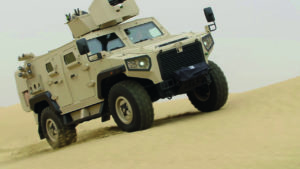
The newest member of Nimr’s ABJAN family of vehicles is the ABJAN 447A MRAV (Multi-Role Armoured Vehicle) introduced at IDEX 2019. The mission profile encompasses tactical response, reconnaissance, counterinsurgency and special operations. The 447A accommodates seven soldiers (two crew plus five dismounts) in forward facing blast attenuated seats. The two front doors are hinged forward while the two rear doors are hinged at the back for quicker egress of the dismounts.
The MRAV accepts a roof-mounted RWS with a choice of machine guns or Gatling guns. It is similar in size to the ABJAN 440 unveiled in 2015, but provides a higher standard level of protection. The engine compartment is also protected. This additional armour increases the basic curb weight to 9,700 kg. Additional modular ballistic and blast armour can be mounted. A self-sealing fuel tank is standard. Road speed tops out at 120 kph. The independent suspension, strengthened axles, and central tire inflation system enhance terrain handling while the cabin’s ergonomic design improves crew comfort over previous vehicles. Off road handling includes crossing a one metre ford, a 78 centimetre trench, and a 40 centimetre obstacle, along with climbing a 60% incline.
Hatehof WOLF
While the majority of 4x4s discussed here employ armoured monocoques, there are exceptions such as the Hatehof WOLF. This vehicle, manufactured by Rafael and by Carmor Integrated Vehicle Solutions (formerly Hatehof ltd.), is based on a commercial off-the-shelf Ford F550 truck, with an armour shell placed over the chassis. This solution reduces costs, and simplifies maintenance and upgrades. Damaged armour can be easily replaced.
Conversely, the armour shell can be lifted off a worn-out vehicle and applied to a new one. The eight-ton vehicle can be equipped with an RWS and carry up to twelve combat troops plus the driver and gunner. It was designed primarily for urban, internal security, and peacekeeping operations, with the intent of replacing the Israeli Defense Force’s (IDF) slower and less mobile M113 APCs in these tasks. Functions include patrol/APC, logistic transport, Medevac, and command vehicle. Aside from the IDF another five operators – including the Romanian army’s military police – currently deploy the WOLF.
Carmor MANTIS
Most recently, Carmor introduced the 6,000 kg MANTIS at Eurosatory 2018. This highly unconventional armoured 4×4 resembles a dune buggy in shape and performance, combining high levels of all-terrain manoeuvrability, survivability and lethality. The driver is seated forward in a cockpit-style configuration, enjoying an enhanced field of vision. The sloped nose of the vehicle further improves visibility. Driver situational awareness is further aided by the all-digital layout, the optional cockpit-integrated night vision, and several side- and rear-mounted cameras which constitute a panoramic surveillance system.
Various configurations are currently available, with passenger capacity ranging from three to six (in addition to the driver, gunner and commander who constitute the basic crew).
The mission profile includes strike, reconnaissance, command and medevac. Top-mounted weapon options include foldable RWS systems or turrets, mounting a choice of automatic weapons (up to 30mm), missiles, or 120mm mortars. The reconnaissance variant can be equipped with a telescopic mast mounting optical and thermal sensors as well as radar. This variant can also deploy unmanned aerial and ground systems.
The MANTIS monocoque incorporates a multi-layer composite armour, with level 3 ballistic protection and level 1 blast protection; this can be upgraded to level 4 ballistic and level 2a/3b blast protection. The sloping, angular hull design also contributes to projectile and blast deflection. Blast protected seats and a floating floor provide further occupant protection against mines and IEDs. VATEC multispectral concealment material applied on the inner and outer surfaces of the monocoque can minimise the vehicle’s infrared, visual, radar and radio-frequency signatures. This not only enhances survivability but provides an overall tactical advantage during surveillance or approach to target. Top speed is 120 kph, range is 700 km.
Paramount MARAUDER
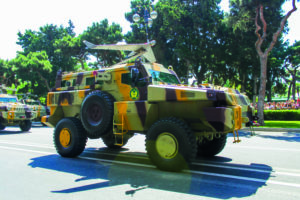
South Africa’s Paramount produces the 4×4 MARAUDER which can be configured as an APC, an ambulance, a command vehicle, or as a fire support vehicle armed with either ATGMs, a turret or an RWS. It is in service with the armed forces of Azerbaijan and several African nations. Depending on configuration, the vehicle weighs 15,000 to 18,000 kg. Payload capacity is 4,500 kg. In the APC mode it carries 2+8 personnel. The extra-large payload capacity permits carriage of extra fuel tanks and supplies, enabling long-range reconnaissance or strike missions. The double-skinned hull armour provides Stanag level 3 ballistic protection. The vehicle has also been tested to survive an 8 kg TNT charge detonating under the hull or a 14 kg mine charge detonating under a wheel; the hull can survive a side-on IED blast equivalent to a 50 kg TNT charge. The very robust chassis and drivetrain permit a top speed of 120 kph over rough terrain, a speed most other armoured vehicles achieve on-road. The operational range is 700 kilometers.
Diversity reigns
A wide range of sizes, payloads, and operational parameters are represented between the extremes of the Textron COMMANDO and the Carmor MANTIS. This underscores the diversity of missions, operating environments, and resources which manufacturers and military services take into account when designing and procuring military systems. The review of current and new 4×4 armoured vehicles underscores that this category of military vehicle is in high demand, and will continue to display a diverse range of design and performance profiles.
Sidney E. Dean








